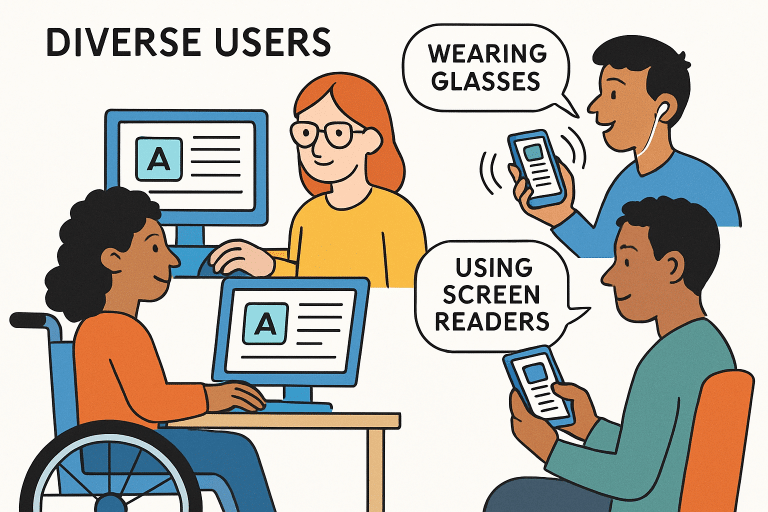Future-Proofing Digital Content Accessibility
Key Takeaways
- Learn why keeping up with accessibility regulations is essential for organizations with a global reach.
- Explore how AI-powered solutions bring efficiency and accuracy to accessible content creation.
- Understand the necessity of regular audits and feedback cycles for maintaining standards.
As online experiences become increasingly essential across industries, digital content accessibility isn’t just about compliance—it’s a foundation for a more equitable internet. Proactive accessibility efforts help organizations serve all users while staying ahead of evolving regulations. Ensuring your documents, websites, and digital communications are inclusively designed requires constant vigilance, the right tools, and ongoing education. Using a PDF accessibility checker early in your workflow helps tackle common barriers, keeping your files compliant and user-friendly in a fast-changing landscape.
Making content accessible from the outset has significant benefits. It expands your audience, fosters community trust, and builds resilience against future legislative shifts. In the EU and worldwide, legal expectations are evolving, with frameworks like the European Accessibility Act (EAA) impacting a global array of businesses. To keep digital materials usable for everyone, adaptability and continuous improvement are crucial. Seamlessly aligning your content creation with accessibility best practices not only fulfills legal obligations but also future-proofs your brand’s reputation.
Understanding Accessibility Laws and Regulations
Digital equality is a growing legal mandate. The European Accessibility Act (EAA), coming into force on June 28, 2025, is among the most comprehensive frameworks. This legislation demands that all businesses offering digital products or services to EU citizens, regardless of physical location, meet set accessibility standards. That means emails, websites, and documents must conform to principles outlined in the Web Content Accessibility Guidelines (WCAG), ensuring content is perceivable (e.g., with alt text and sufficient color contrast), operable, understandable, and robust for use with assistive technologies. These requirements are mirrored in other jurisdictions, with U.S. Section 508 and Canada’s Accessible Canada Act also driving accessibility best practices globally.
Implementing AI-Driven Accessibility Tools
The rapid advancement of AI provides fresh opportunities to automate and optimize accessibility programs. Tools such as AltGen streamline alt text creation for images, making visual content accessible at scale for users relying on screen readers. AI models are now capable of producing nuanced, context-relevant alt text and flagging accessibility errors that previously required manual review. Leveraging such solutions ensures your content isn’t just compliant at launch but remains consistently accessible as you update and expand your digital assets.
Conducting Regular Accessibility Audits
Even well-designed digital properties require ongoing attention to safeguard accessibility. Scheduled audits by internal teams or external experts reveal new issues introduced by content updates, design refreshes, or shifts in guidance. Organizations like CultureSuite now provide sector-specific audit solutions—particularly vital for museums, galleries, and other cultural institutions aiming to open their resources to broader audiences in line with EAA requirements. Regular self-assessments, remediation, and transparent reporting pave the way for unmatched digital inclusion.
Incorporating User Feedback
True accessibility emerges when people with lived experience are central to the feedback loop. Engaging users with diverse disabilities early and often helps you uncover friction points missed in technical reviews. Methods include usability testing, direct surveys, and maintaining open channels for reporting barriers. This participatory approach not only improves digital products but also signals your brand’s authentic commitment to inclusive design.
Training and Awareness
Accessibility know-how must permeate every layer of your organization. Training designers, developers, content creators, marketers, and leadership equips teams to spot inaccessible elements before they become entrenched. Consistent training builds empathy, encourages curiosity about new tools, and keeps accessibility central as digital strategies shift. Resources from major tech education providers and organizations like the W3C Web Accessibility Initiative enable ongoing, up-to-date learning for staff at every skill level.
Utilizing Assistive Technologies
Modern assistive technologies—ranging from screen readers and text-to-speech applications to voice recognition software—enable people with disabilities to access content on their own terms. Ensuring compatibility through semantic HTML, keyboard navigation, and ARIA roles makes all content easier to use. These tools aren’t just helpful; they’re essential for real-world usability and compliance. Developers should continuously test sites and files with current assistive technologies to validate user experiences.
Monitoring Technological Advancements
The accessibility landscape is constantly evolving, and so are the tools to enhance it. Monitoring the adoption of new methods—like AR and VR accessibility in healthcare and education—positions organizations to deliver innovative, inclusive user experiences. Staying connected to emerging research, global policy updates, and evolving standards will help you adapt more easily as user expectations change and new markets open up.
Conclusion
Building an accessible digital future requires more than one-off compliance. By investing in accessible-by-design principles, leveraging AI for efficiency, conducting regular audits, seeking authentic user involvement, upskilling everyone on your teams, and adopting proven assistive tech, you set a course for digital content that stands the test of time. These steps aren’t only about meeting legal requirements—they’re key to fostering innovation, trust, and lasting engagement in an ever-diversifying digital world.
